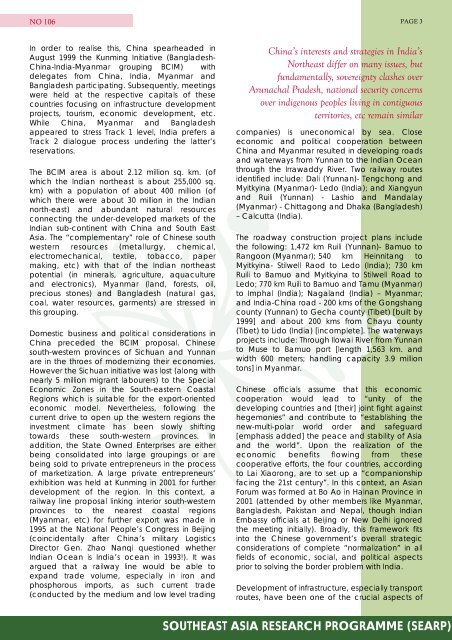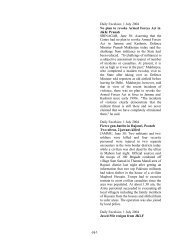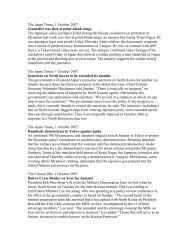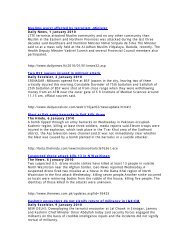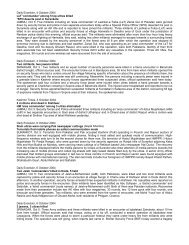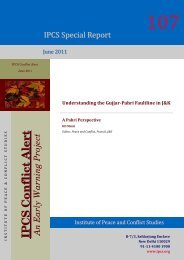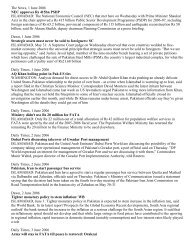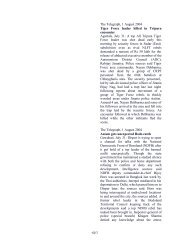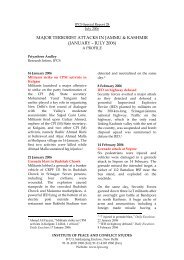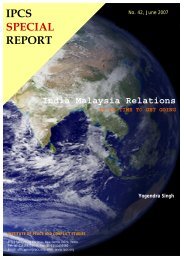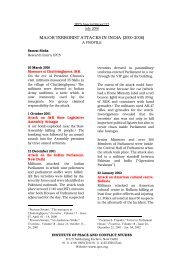India's Northeast and Southeast Asia - Institute of Peace and Conflict ...
India's Northeast and Southeast Asia - Institute of Peace and Conflict ...
India's Northeast and Southeast Asia - Institute of Peace and Conflict ...
You also want an ePaper? Increase the reach of your titles
YUMPU automatically turns print PDFs into web optimized ePapers that Google loves.
NO 106<br />
PAGE 3<br />
In order to realise this, China spearheaded in<br />
August 1999 the Kunming Initiative (Bangladesh-<br />
China-India-Myanmar grouping BCIM) with<br />
delegates from China, India, Myanmar <strong>and</strong><br />
Bangladesh participating. Subsequently, meetings<br />
were held at the respective capitals <strong>of</strong> these<br />
countries focusing on infrastructure development<br />
projects, tourism, economic development, etc.<br />
While China, Myanmar <strong>and</strong> Bangladesh<br />
appeared to stress Track 1 level, India prefers a<br />
Track 2 dialogue process underling the latter’s<br />
reservations.<br />
The BCIM area is about 2.12 million sq. km. (<strong>of</strong><br />
which the Indian northeast is about 255,000 sq.<br />
km) with a population <strong>of</strong> about 400 million (<strong>of</strong><br />
which there were about 30 million in the Indian<br />
north-east) <strong>and</strong> abundant natural resources<br />
connecting the under-developed markets <strong>of</strong> the<br />
Indian sub-continent with China <strong>and</strong> South East<br />
<strong>Asia</strong>. The “complementary” role <strong>of</strong> Chinese south<br />
western resources (metallurgy, chemical,<br />
electromechanical, textile, tobacco, paper<br />
making, etc) with that <strong>of</strong> the Indian northeast<br />
potential (in minerals, agriculture, aquaculture<br />
<strong>and</strong> electronics), Myanmar (l<strong>and</strong>, forests, oil,<br />
precious stones) <strong>and</strong> Bangladesh (natural gas,<br />
coal, water resources, garments) are stressed in<br />
this grouping.<br />
Domestic business <strong>and</strong> political considerations in<br />
China preceded the BCIM proposal. Chinese<br />
south-western provinces <strong>of</strong> Sichuan <strong>and</strong> Yunnan<br />
are in the throes <strong>of</strong> modernizing their economies.<br />
However the Sichuan initiative was lost (along with<br />
nearly 5 million migrant labourers) to the Special<br />
Economic Zones in the South-eastern Coastal<br />
Regions which is suitable for the export-oriented<br />
economic model. Nevertheless, following the<br />
current drive to open up the western regions the<br />
investment climate has been slowly shifting<br />
towards these south-western provinces. In<br />
addition, the State Owned Enterprises are either<br />
being consolidated into large groupings or are<br />
being sold to private entrepreneurs in the process<br />
<strong>of</strong> marketization. A large private entrepreneurs’<br />
exhibition was held at Kunming in 2001 for further<br />
development <strong>of</strong> the region. In this context, a<br />
railway line proposal linking interior south-western<br />
provinces to the nearest coastal regions<br />
(Myanmar, etc) for further export was made in<br />
1995 at the National People’s Congress in Beijing<br />
(coincidentally after China’s military Logistics<br />
Director Gen. Zhao Nanqi questioned whether<br />
Indian Ocean is India’s ocean in 1993!). It was<br />
argued that a railway line would be able to<br />
exp<strong>and</strong> trade volume, especially in iron <strong>and</strong><br />
phosphorous imports, as such current trade<br />
(conducted by the medium <strong>and</strong> low level trading<br />
China’s interests <strong>and</strong> strategies in India’s<br />
<strong>Northeast</strong> differ on many issues, but<br />
fundamentally, sovereignty clashes over<br />
Arunachal Pradesh, national security concerns<br />
over indigenous peoples living in contiguous<br />
territories, etc remain similar<br />
companies) is uneconomical by sea. Close<br />
economic <strong>and</strong> political cooperation between<br />
China <strong>and</strong> Myanmar resulted in developing roads<br />
<strong>and</strong> waterways from Yunnan to the Indian Ocean<br />
through the Irrawaddy River. Two railway routes<br />
identified include: Dali (Yunnan)- Tengchong <strong>and</strong><br />
Myitkyina (Myanmar)- Ledo (India); <strong>and</strong> Xiangyun<br />
<strong>and</strong> Ruili (Yunnan) - Lashio <strong>and</strong> M<strong>and</strong>alay<br />
(Myanmar) - Chittagong <strong>and</strong> Dhaka (Bangladesh)<br />
– Calcutta (India).<br />
The roadway construction project plans include<br />
the following: 1,472 km Ruili (Yunnan)- Bamuo to<br />
Rangoon (Myanmar); 540 km Heinnitang to<br />
Myitkyina- Stilwell Raod to Ledo (India); 730 km<br />
Ruili to Bamuo <strong>and</strong> Myitkyina to Stilwell Road to<br />
Ledo; 770 km Ruili to Bamuo <strong>and</strong> Tamu (Myanmar)<br />
to Imphal (India); Nagal<strong>and</strong> (India) – Myanmar;<br />
<strong>and</strong> India-China road - 200 kms <strong>of</strong> the Gongshang<br />
county (Yunnan) to Gecha county (Tibet) [built by<br />
1999] <strong>and</strong> about 200 kms from Chayu county<br />
(Tibet) to Lido (India) [incomplete]. The waterways<br />
projects include: Through Ilowai River from Yunnan<br />
to Muse to Bamuo port [length 1,563 km. <strong>and</strong><br />
width 600 meters; h<strong>and</strong>ling capacity 3.9 million<br />
tons] in Myanmar.<br />
Chinese <strong>of</strong>ficials assume that this economic<br />
cooperation would lead to “unity <strong>of</strong> the<br />
developing countries <strong>and</strong> [their] joint fight against<br />
hegemonies” <strong>and</strong> contribute to “establishing the<br />
new-multi-polar world order <strong>and</strong> safeguard<br />
[emphasis added] the peace <strong>and</strong> stability <strong>of</strong> <strong>Asia</strong><br />
<strong>and</strong> the world”. Upon the realization <strong>of</strong> the<br />
economic benefits flowing from these<br />
cooperative efforts, the four countries, according<br />
to Lai Xiaorong, are to set up a “companionship<br />
facing the 21st century”. In this context, an <strong>Asia</strong>n<br />
Forum was formed at Bo Ao in Hainan Province in<br />
2001 (attended by other members like Myanmar,<br />
Bangladesh, Pakistan <strong>and</strong> Nepal, though Indian<br />
Embassy <strong>of</strong>ficials at Beijing or New Delhi ignored<br />
the meeting initially). Broadly, this framework fits<br />
into the Chinese government’s overall strategic<br />
considerations <strong>of</strong> complete “normalization” in all<br />
fields <strong>of</strong> economic, social, <strong>and</strong> political aspects<br />
prior to solving the border problem with India.<br />
Development <strong>of</strong> infrastructure, especially transport<br />
routes, have been one <strong>of</strong> the crucial aspects <strong>of</strong><br />
SOUTHEAST ASIA RESEARCH PROGRAMME (SEARP)


